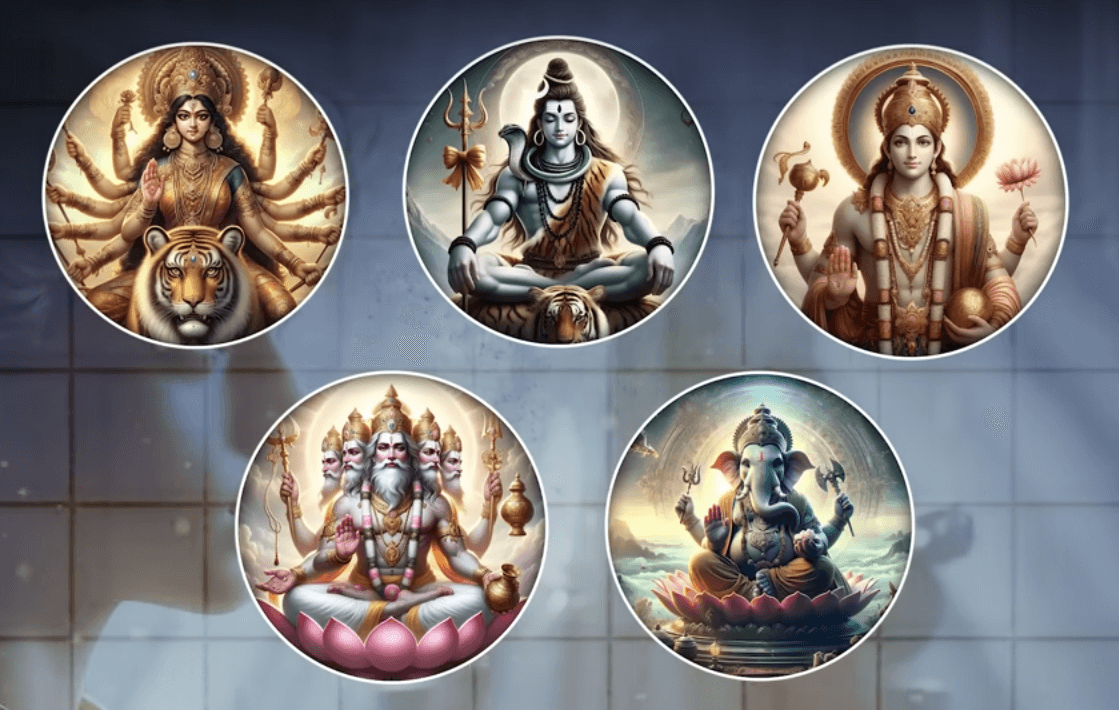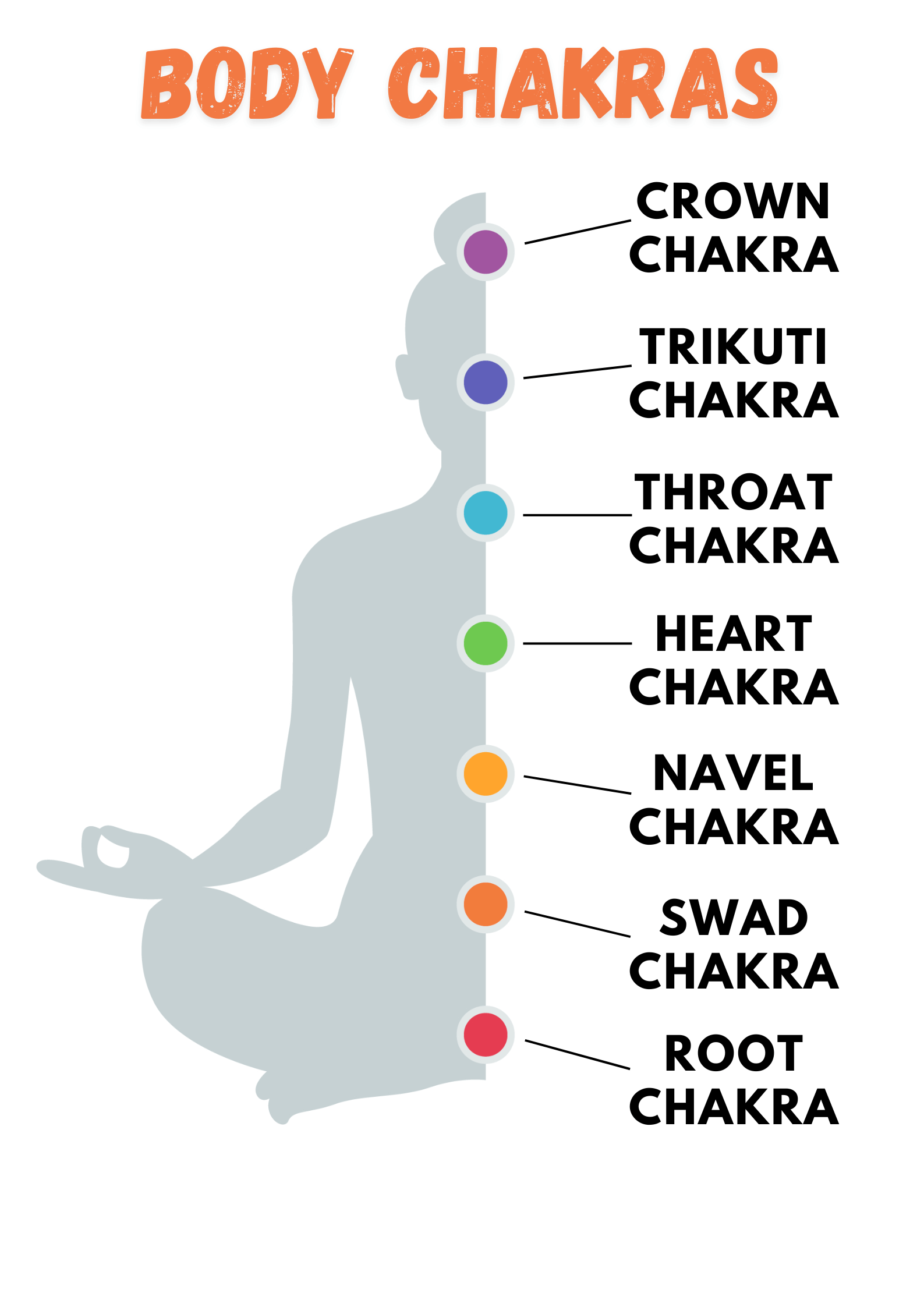Panch Dev Pooja

Panch Dev Pooja: Worship of the Five Deities Residing in the Chakras
Panch Dev Pooja—also known as Panch Devta Pooja or Panch Dev Upasna—is an ancient spiritual practice rooted in Sanatan tradition. It refers to the worship of five principal deities believed to dwell within specific lotuses or chakras of the human body.
What are the Panch Devs
Panch Dev refers to the five principal deities traditionally worshipped in Sanatan Dharma—
- Lord Ganesha
- Lord Brahma with Goddess Savitri
- Lord Vishnu with Goddess Lakshmi
- Lord Shiva with Goddess Parvati
- Goddess Durga (also known as Ashtangi or Prakriti Devi)
These deities are believed to reside within the subtle energy centers, or chakras (kamals), of the human body. Lord Ganesha is seated in the Mool Kamal (Root Chakra), Brahma-Savitri in the Swadhisthana Kamal (Sacral Chakra), Vishnu-Lakshmi in the Nabhi Kamal (Navel Chakra), Shiva-Parvati in the Hridaya Kamal (Heart Chakra), and Goddess Durga in the Kanth Kamal (Throat Chakra). The practice of Panch Dev Pooja involves invoking these deities through specific mantras to awaken each chakra and guide the soul upward on its journey toward the Supreme Abode.

Five Deities and their associated Chakras in detail
- In the Mool Kamal (Root Chakra), which has four petals, resides Lord Ganesha. A specific mantra is used to unlock the gateway of this chakra—this is the primary mantra for invoking Lord Ganesha. When practiced sincerely, it pleases Lord Ganesha, who grants swift blessings and opens the door for the soul to ascend. From here, the soul begins its spiritual journey toward higher realms, ultimately aiming to reach the Supreme Abode from where there is no return to the material world.
- Next is the Swadhisthana Kamal (Sacral Chakra), located above the Mool Kamal. This chakra has six petals and is the seat of Lord Brahma and his consort Goddess Savitri. A distinct mantra unlocks this chakra. When practiced correctly, Lord Brahma opens its door, allowing the soul to ascend further.
- Above this lies the Nabhi Kamal (Navel Chakra), with eight petals. Lord Vishnu and Goddess Lakshmi dwell here. The gateway to this chakra is also closed by default. Through devotional chanting of its associated mantra, these deities are pleased and open the passage for the soul to move upward.
- The journey continues to the Hriday Kamal (Heart Chakra), which has twelve petals. Here reside Lord Shiva and Goddess Parvati. Like the earlier chakras, this one too remains sealed until the practitioner chants the appropriate mantra with devotion. When pleased, Shiva and Parvati open this chakra and guide the soul further upward.
- Finally, the soul reaches the Kanth Kamal (Throat Chakra), which contains sixteen petals. This chakra is the abode of Goddess Durga (Ashtangi or Prakriti Devi). Its entrance also remains shut until activated by a sacred mantra. Upon being pleased, Goddess Durga opens the gate, allowing the soul to progress toward the Trikuti Kamal, the next stage on the spiritual ascent toward the Supreme Being.
Panch Dev Pooja is a sacred and transformative practice that honors the divine powers operating within the human body. By understanding and reverently connecting with the five deities who dwell in the bodily chakras, the spiritual seeker not only enhances their physical and mental well-being but also progresses to the next stage of spirituality called the Sanatani worship.
Ultimately, Panch Dev Upasna lays the foundation for deeper spiritual realization—helping the soul to accept the Sanatani and Adi Sanatani worship. Without Panch Dev Pooja, a worshipper cannot ascend to the next stage i.e. Sanatani pooja.
What is Sanatani Worship?
Panch Dev Pooja serves as the foundational stage of spiritual practice, enabling the soul to begin its inward journey by awakening the body’s chakras and paying off debts for the five primary deities. This basic worship prepares the aspirant for the next level known as Sanatani Pooja or Sanatani Worship, which involves invoking higher cosmic powers—Kaal, the master of 21 universes, and ParBrahm (Akshar Purush), the ruler of 700 quadrillion universes. Through the chanting of specific mantras, a devotee pays off the karmic and energetic debts owed to these entities for residing and passing through their respective realms. However, the ultimate goal of the soul is not to remain in service to these powerful beings but to reach the Supreme God, who is beyond Kaal and Akshar Purush. True liberation lies in connecting with this Supreme Being, the only entity truly worthy of worship. All other forms of worship serve as transitional steps in settling cosmic accounts and progressing toward eternal salvation.
What is Aadi Sanatani Worship?
Aadi Sanatani Worship is the highest and most ancient form of true devotion directed solely toward the Supreme God, who is beyond Kaal and Akshar Purush. This level of worship can only be attained after completing Panch Dev Pooja and Sanatani Worship, and only when it is properly received from a Complete Saint (Tatvdarshi Sant), as prescribed in the scriptures.
The essence of Aadi Sanatani Worship is revealed in Bhagavad Gita Chapter 17 Verse 23, where it states: "Om Tat Sat". Here, Om represents the worship of Kaal (Brahm), Tat refers to the mantra of Akshar Purush (ParBrahm), and Sat points to the Supreme God—the eternal truth and the ultimate liberator. Together, Om Tat Sat forms the complete mantra of Aadi Sanatani Worship, guiding the soul beyond the bondage of the lower realms into the eternal abode of the Supreme God. This is the final stage of spiritual practice, where true liberation (moksha) is attained.
Shri Krishna - A Scriptural Analysis Age of Lord Brahma
Categories: hinduism | Tags:
